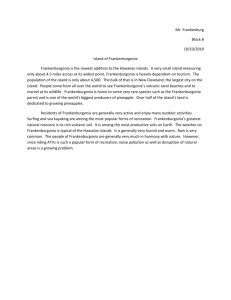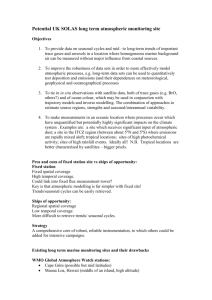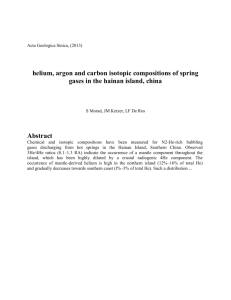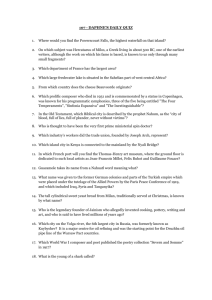Gualtieri, L., Vartanyan, S., Anderson, P. and Brigham
advertisement
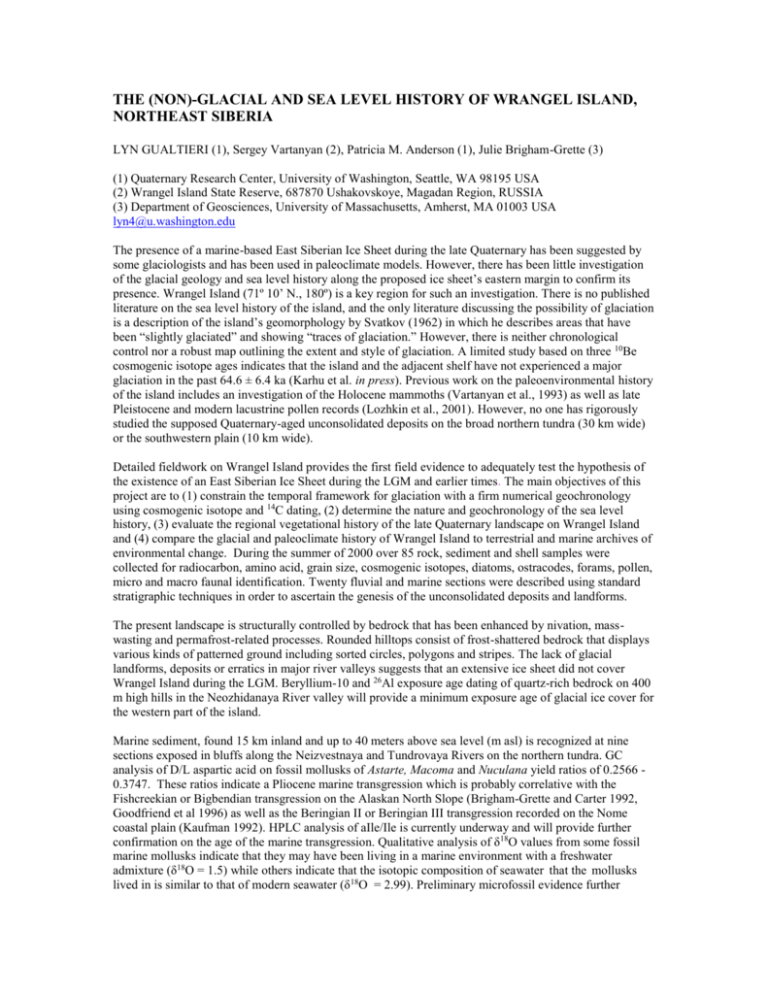
THE (NON)-GLACIAL AND SEA LEVEL HISTORY OF WRANGEL ISLAND, NORTHEAST SIBERIA LYN GUALTIERI (1), Sergey Vartanyan (2), Patricia M. Anderson (1), Julie Brigham-Grette (3) (1) Quaternary Research Center, University of Washington, Seattle, WA 98195 USA (2) Wrangel Island State Reserve, 687870 Ushakovskoye, Magadan Region, RUSSIA (3) Department of Geosciences, University of Massachusetts, Amherst, MA 01003 USA lyn4@u.washington.edu The presence of a marine-based East Siberian Ice Sheet during the late Quaternary has been suggested by some glaciologists and has been used in paleoclimate models. However, there has been little investigation of the glacial geology and sea level history along the proposed ice sheet’s eastern margin to confirm its presence. Wrangel Island (71º 10’ N., 180º) is a key region for such an investigation. There is no published literature on the sea level history of the island, and the only literature discussing the possibility of glaciation is a description of the island’s geomorphology by Svatkov (1962) in which he describes areas that have been “slightly glaciated” and showing “traces of glaciation.” However, there is neither chronological control nor a robust map outlining the extent and style of glaciation. A limited study based on three 10Be cosmogenic isotope ages indicates that the island and the adjacent shelf have not experienced a major glaciation in the past 64.6 ± 6.4 ka (Karhu et al. in press). Previous work on the paleoenvironmental history of the island includes an investigation of the Holocene mammoths (Vartanyan et al., 1993) as well as late Pleistocene and modern lacustrine pollen records (Lozhkin et al., 2001). However, no one has rigorously studied the supposed Quaternary-aged unconsolidated deposits on the broad northern tundra (30 km wide) or the southwestern plain (10 km wide). Detailed fieldwork on Wrangel Island provides the first field evidence to adequately test the hypothesis of the existence of an East Siberian Ice Sheet during the LGM and earlier times. The main objectives of this project are to (1) constrain the temporal framework for glaciation with a firm numerical geochronology using cosmogenic isotope and 14C dating, (2) determine the nature and geochronology of the sea level history, (3) evaluate the regional vegetational history of the late Quaternary landscape on Wrangel Island and (4) compare the glacial and paleoclimate history of Wrangel Island to terrestrial and marine archives of environmental change. During the summer of 2000 over 85 rock, sediment and shell samples were collected for radiocarbon, amino acid, grain size, cosmogenic isotopes, diatoms, ostracodes, forams, pollen, micro and macro faunal identification. Twenty fluvial and marine sections were described using standard stratigraphic techniques in order to ascertain the genesis of the unconsolidated deposits and landforms. The present landscape is structurally controlled by bedrock that has been enhanced by nivation, masswasting and permafrost-related processes. Rounded hilltops consist of frost-shattered bedrock that displays various kinds of patterned ground including sorted circles, polygons and stripes. The lack of glacial landforms, deposits or erratics in major river valleys suggests that an extensive ice sheet did not cover Wrangel Island during the LGM. Beryllium-10 and 26Al exposure age dating of quartz-rich bedrock on 400 m high hills in the Neozhidanaya River valley will provide a minimum exposure age of glacial ice cover for the western part of the island. Marine sediment, found 15 km inland and up to 40 meters above sea level (m asl) is recognized at nine sections exposed in bluffs along the Neizvestnaya and Tundrovaya Rivers on the northern tundra. GC analysis of D/L aspartic acid on fossil mollusks of Astarte, Macoma and Nuculana yield ratios of 0.2566 0.3747. These ratios indicate a Pliocene marine transgression which is probably correlative with the Fishcreekian or Bigbendian transgression on the Alaskan North Slope (Brigham-Grette and Carter 1992, Goodfriend et al 1996) as well as the Beringian II or Beringian III transgression recorded on the Nome coastal plain (Kaufman 1992). HPLC analysis of aIle/Ile is currently underway and will provide further confirmation on the age of the marine transgression. Qualitative analysis of δ18O values from some fossil marine mollusks indicate that they may have been living in a marine environment with a freshwater admixture (δ18O = 1.5) while others indicate that the isotopic composition of seawater that the mollusks lived in is similar to that of modern seawater (δ18O = 2.99). Preliminary microfossil evidence further supports a Pliocene/Early Pleistocene age for the marine sediment. These shorelines are clearly eustatic in origin and no evidence has been found so far for glacioisostatic unloading. Ongoing pollen analysis and radiocarbon age estimates on individual fragments of plants, wood, mammoth teeth and bones collected from bluffs exposed along the Mammontovaya River, on the southwestern part of the island, will further help to provide a chronology of paleoenvironmental change. Fieldwork in 2001 and 2002 is planned to search for more raised marine deposits on the northern tundra as well as to investigate the highest areas of the central mountains for evidence of glaciation. References: Brigham-Grette, J. and Carter, L.D. 1992. Pliocene marine transgressions of Northern Alaska: Circumarctic Correlations and Paleoclimatic Interpretations. Arctic 45 (1): 74-89. Goodfriend, G. A., Brigham-Grette, J. and Miller, G.H. 1996. Enhanced age resolution of the marine Quaternary record in the Arctic using aspartic acid racemization dating of bivalve shells. Quaternary Research 45: 176-187. Karhu, J. A., Tschudi, S., Saarnisto, M., Kubik, P.W., Schlüchter, C. in press. Constraints for the latest glacial advance on Wrangel Island, Arctic Ocean, from rock surface exposure dating. Global and Planetary Change. Kaufman, D.S. 1992. Aminostratigraphy of Pliocene-Pleistocene high-sea-level deposits, Nome coastal plain and adjacent nearshore area, Alaska. Geological Society of America Bulletin 104: 40-52. Lozhkin, A.V., Anderson, P.M., Vartanyan, S.L., Brown, T.A., Belaya, B.V. and Kotov, A.N. 2001. Late Quaternary paleoenvironments and modern pollen data from Wrangel Island (Northern Chukotka). Quaternary Science Reviews 20: 217-233. Svatkov, N.M. 1962. Natural features of Wrangel Island. Problemy Severa 4: 2-26. Vartanyan, S.L., Garutt, V.E., and Sher, A.V. 1993. Holocene dwarf mammoths from Wrangel Island in the Siberian Arctic. Nature 362: 337-340.


